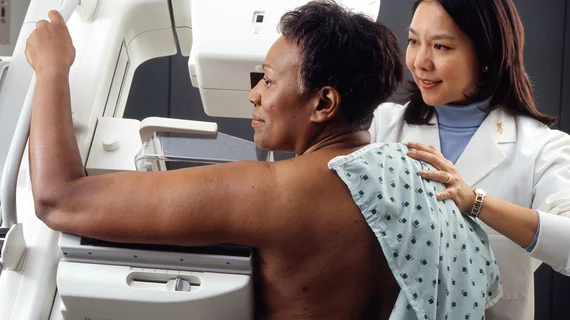Low mammography quality leads to more false positives, less comfort for women
Low mammography quality has been linked to an increase in false positives, Canadian radiologists reported this month. Such a decrease in standard of care could be compromising patient comfort during an already-disconcerting procedure.
High-quality mammography ensures clear visualization of all breast tissue and is expected to reduce false positives and poor diagnoses, Marie-Hélène Guertin, PhD, and colleagues wrote in the Canadian Association of Radiologists Journal. Compromising the quality of mammograms means lower screening sensitivity, later cancer diagnosis and, in some cases, the possibility of a missed diagnosis.
“Mammography quality could also affect the false positive rate,” Guertin and co-authors said. “False positives are a frequent disadvantage of screening; they induce anxiety for recalled women as well as additional imaging, radiation and costs.”
At their facilities in Québec, Canada, the authors said their breast cancer screening program is assessed periodically for quality assurance—programs must be accredited and evaluated every three years by the Canadian Association of Radiologists (CAR), and facilities must be certified by the Laboratoire de Santé Publique du Québec after annual visits.
“Despite these efforts, mammography quality in daily practice still appears to vary substantially,” Guertin et al. wrote. “To our knowledge, no study has evaluated the impact of clinical image quality on the false positive rate.”
The research team recruited a CAR-certified radiologist to analyze the mammography quality of a random sample of screen-film mammograms, scoring each image for positioning, compression, contrast, exposure level, sharpness and artifacts. A final overall quality score was attributed to each scan.
Guertin and colleagues found that among 1,209 women without cancer, 104 recorded false positives between 2004 and 2005 in Québec. Lower overall mammography quality was associated with the 40 percent increase in the false positive rate, the authors said, but the uptick wasn’t statistically significant. What did make an impact, though, was artifacts.
“Artifacts were associated with a statistically significant doubling of the false positive rate,” Guertin and her team said. “Artifacts can create pseudolesions and therefore increase the recall rate for mammograms with such problems.”
Lower quality scores for all other factors, like sharpess and compression, were linked to anywhere between a 10 and 30 percent increase in the false positive rate, the authors said, but those numbers were also statistically insignificant.
“In practice, all screening mammograms cannot satisfy the CAR quality criteria, even when done by the best technologists,” the researchers wrote. “Women’s body habitus, as well as their capability to collaborate, will sometimes prevent even an experienced technologist from doing a mammogram that satisfies all quality accreditation standards. It is important to monitor mammography quality and its impact on both screening sensitivity and specificity, as this may help ensure that the balance between benefits and disadvantages of screening remains positive for women.”

